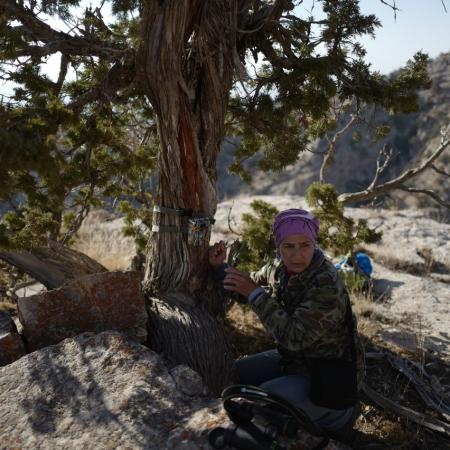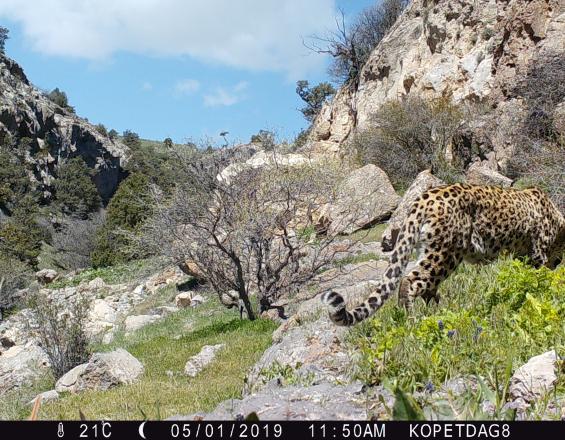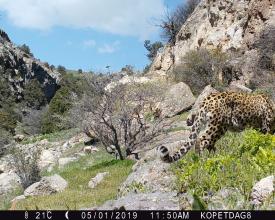
Using camera traps to restore connectivity for wild cats in Central Asia

Located in the central part of the Kopetdag Range in the Ahal Province of Turkmenistan and spanning an area of 497 km2, Central Kopet Dag Reserve incorporates two sanctuaries and two natural monuments.
This Reserve is the most important stronghold in Turkmenistan for the conservation of the Persian leopard (Panthera pardus saxicolor) and recently the presence of the Pallas cat (Otocolubus manul), a relatively rare small wild cat, rediscovered. The Reserve is the gateway between Iran and areas to the north and west into Kazakhstan for the Persian leopard. Since 2018, thanks to the collaboration between protected area staff and international partners, an effort is underway to establish baseline information on all cat species, the status of their important prey (the Urial and Bezoar goat), and to identify threats, including the impacts of the border fence with Iran. Twenty camera traps have been deployed that to date have enabled to identify several Persian leopards as well as record the Pallas cat.
Context
Challenges addressed
Like other protected areas in Turkmenistan, the Central Kopet Dag Reserve suffers from a lack of resources, financial and technical and greater opportunities for staff to build their skills and knowledge.
The other big challenge is that most of the Reserve falls within the border zone.Therefore it is challenging for Reserve staff to have access regularly for monitoring and patrolling.
Location
Process
Summary of the process
The data generated through monitoring can be a powerful communication and awareness-raising tool that allows to create bridges between the protected areas and local communities. Local communities can then be included through a “citizen science” approach where members of communities feel empowered by the sheer act of contributing important information to protected area staff.
Building Blocks
Camera traps monitoring
Camera traps have revolutionized wildlife research and conservation, enabling scientists to collect photographic evidence of rarely seen and often globally endangered species, with little expense, relative ease, and minimal disturbance to wildlife. We use them to document wildlife presence, abundance, and population changes, particularly in the face of habitat loss and poaching.
Camera traps are also used to raise conservation awareness worldwide, as a way of reaching out to the public through the internet and social media.
Enabling factors
Funding for the equipment, and having staff trained and enthusiastic to use them are critical. Also, the support and approval of the government are essential, especially since camera traps can be “weaponized” against researchers themselves when suddenly they are considered tools for spying.
Lesson learned
It is key to have government's support and participation and make sure that the government knows what data is acquired through camera traps. When camera trapping is set in sensitive areas, it’s important that the government partners take decisions as to how the information and images acquired are stored and shared.
Addressing human-wildlife conflict in buffer zone
Protected areas are a sanctuary for complex species like the Persian leopard, but the moment they leave the safety of the protected area they run into herder camps, their dogs and livestock, increasing the chance that leopards may kill the livestock. Herders may respond by killing the leopards. When protected area staff have good communication with communities in the buffer zone and support them by helping them mitigate the conflict or even better prevent it through the use of several conflict prevention tools, the acceptance of local communities towards leopards can increase.
Enabling factors
Communication between protected area staff and local communities;
presentation by protected area staff on wildlife monitoring work done and workshops as opportunities to raise concerns over the presence of leopards and strengthen bonds.
Lesson learned
Effective communication and exchanges lead to greater acceptance of leopards as well as identification of hotspots that enable to more efficiently take preventative measures.
Impacts
Communication and collaboration with Border Security authorities and local communities helped to better understand the conflict between leopards and livestock as well as developed ideas as to how border fences could be modified to restore connectivity without compromising national security.
Gathered data and experience have been used to make the case for the inclusion of the Persian leopard under the Convention on the Conservation of Migratory Species of Wild Animals (CMS) Central Asian Mammals Initiative and sealed the commitment of Turkmenistan to join the Convention in January 2021. By joining CMS, the importance of the Reserve as a case study for restoring connectivity became even greater.
The important monitoring results have been used for outreach and messaging on the value of protected areas and of protecting species. Several documentaries have been broadcasted on state TV. As a result, there is a greater appreciation for the conservation of wildlife, especially wild cats.
Sharing of data and information with conservationists in neighbouring Iran has also showed that Persian leopards cross from Iran into the Reserve in Turkmenistan, albeit severely affected by border fences, and come very close to the country’s capital.
Beneficiaries
- scientists and rangers of the Central Kopet Dag Reserve
- wildlife of the Reserve, including the approximately 20 leopards inhabiting it
- the local communities benefit from initiatives aimed at reducing human-wildlife conflict
Sustainable Development Goals
Story

Stas Fatayev is a forester by training and was critical in leading the first monitoring efforts in the Kopet Dag in 2010's. He helped capture the leopards that have been taken to Sochi to kick start the leopard breeding program and northern Caucasus reintroduction efforts. Stas works for the Ashgabat airport but as an alpinist and lover of nature and leopards, he spends all of his free time in the mountains and is an invaluable resource and support for Aknabat Potayeva, the Science Lead in the Central Kopet Dag reserve. He knows of every nook, leopard trail and “who’s who” in the leopard kingdom. He often runs into them. He says leopards can smell “fear” and if you are not afraid, they just move on. He is not afraid of them.
Up in Marcow, the “snake den”, on a rainy, cold and foggy day we scaned for places to place cameras. Stas said leopards loved these misty days to move and stalk their prey. Finally, we found a promising spot, after clambering over some wet rock. Stas, with the help of Aman Kurbonov, who also used to be a scientific collaborator of the Central Kopet Dag reserve, found good rocks to build a camera trap tower.
Persian leopards are one of the most imperilled and yet under-prioritized species for conservation and funding. We advocate for that to change by supporting existing efforts in the Caucasus and Iran and new intensive research and conservation work in Turkmenistan, paving the way for developing both a national Action Plan and a regional strategy for the conservation of the species. Persian leopard conservation across borders, championed by using the Convention on Migratory Species Central Asian Mammals Initiative platform, could be a way for Turkmenistan to lead the way in securing a future for this species, by connecting countries and their people and having them join hands in the conservation of the leopard.
The famous Turkmen poet Magtymguly wrote of tigers inhabiting the Sunt Hasar mountains in the 18th century. They disappeared in the early 20th century. We don’t want Persian leopards to be remembered as a thing of the past. We want to work to ensure that the presence of healthy leopard populations is regarded as a symbol of a modern state’s commitment to environmental sustainability.




